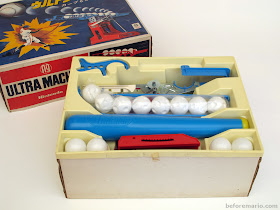 |
| Kôsenjû Custom Lever Action Rifle (1971) |
Released in 1971 as part of the Kôsenjû Custom (光線銃 カスタム) series, it is a light beam gun which can be used to shoot the Kôsenjû SP and Kôsenjû Custom targets.
 |
| It was expensive at ¥14,000. The price later dropped to ¥7,800, then ¥5,000 |
The Custom Lever Action Rifle is a little over one meter in length and has a healthy weight of 2.3 kg. It is made from metal and heavy plastic (with a wood-like finish) and feels like handling the real thing.
It must be one of the most realistic toy rifles out there. I am pretty sure something like this cannot be sold anymore in a toy store today. Recently one was shipped to me from Japan by regular mail, and I was surprised Japan Post accepted it, and the package made it through customs without a problem. That must be encouraging news for the arms smugglers within our readership.
 |
| The lever is used to load the rifle |
Anyway, back to the riffle. Why is it called Lever Action Rifle, you want to know?
 |
| Pulling the lever pushes out the hammer |
Well, easy: you use a lever to load the rifle and prepare it for action.
 |
| The rifle is loaded! |
Once the rifle has been loaded, pulling the trigger will release the hammer with a nice heavy clunk. A small light bulb will flash in the barrel of the gun, beaming towards the target and hitting it. That is, if the shot was well aimed, of course.
The Custom Lever Action Rifle is capable of hitting a target at great distances, thanks to a strong flash light powered by 4 C cells. The manual claims distances between 30 and 100 meters are possible.
If we look at the box more closely, we see a telescopic sight mounted on the rifle. That could come in handy when shooting a target at these kind of distances! However, even though it is pictured on the box, it does not come with the rifle.
 |
| Wait a minute... that scope is not included! |
Fortunately, the scope could be bought separately, as an accessory. Unfortunately, while the rifle itself is not very rare, the scope was sold in very small quantities, making it one of the most difficult to find Nintendo items these days.
 |
| Custom Lever Action Rifle Scope (1971) |
The official name is Custom Lever Action Rifle Scope (レバーアクション ライフル スコープ). It was sold for ¥3,800.
 |
| Custom Lever Action Rifle Scope |
The Scope is a high quality optical piece. It comes with two protective caps.
Magnification of 4 x 20 is provided by the scope.
 |
| Mounting the scope - step 1 |
The scope is mounted on the riffle using the included screwdriver. First we attach a metal slider.
 |
| Mounting the scope - step 2 |
As the rifle itself was already pretty expensive, most people will have skipped buying the scope accessory. They will definitely have missed something though, as the rifle with scope is looking seriously impressive, and made hitting a target at great distance an achievable reality.
 |
| Mounting the scope - step 3 |
We are now ready to take a sniper shot at Custom Gunman. Alternatively, take a look at this Lever Action Rifle poster.





















































